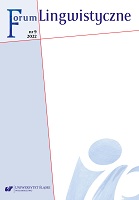Struktura współczesnej mediolingwistyki rosyjskiej
The Structure of Contemporary Russian Medialinguistics
Author(s): Lilija R. DuskajevaSubject(s): Media studies, Applied Linguistics, Communication studies, Eastern Slavic Languages, Philology
Published by: Wydawnictwo Uniwersytetu Śląskiego
Keywords: media text; medialinguistics; four parts of medialinguistics; the grammar of media speech; mediastylistics; medialinguistic discourse research; criticism of media speech;
Summary/Abstract: At the intersection of two scientific areas - linguistics and media theory - a third one has formed - medialinguistics. The creation of discipline was influenced by both extra and intralinguistic factors. In the process of shaping the scientific discipline, the object of analysis was formed, which is the media text functioning in a variety of forms: from Twitter entries to media hypertext presented in information waves. The subject matter of medialinguistics became clear, too: the speech activity reflected in different forms of media texts. The interest in media activity induced the author to turn to praxeology - the philosophical theory of activity, fully developed in the Polish philosophy by Tadeusz Kotarbiński. Praxeology indicates to medialinguistics the logic of studying speech activities: from building typologies of means of action, through the establishment of effective regulatory systems of action and identification of operating procedures, to the criticism of human actions from the point of view of their virtues and the criticism of the methods used in these actions. The article shows the formation of medialinguistics as a four-field scientific discipline. In each of the selected scientific fields of medialinguistics, the scope of research tasks and approaches to their implementation are specified. Highlighted areas reveal different sides of effective speech activity in the media environment: the means of speech activity, the regulatory means of implementation of communicative and social actions in media texts, the intertext sets, or media discourses and their structure, and finally, the demonstration of “language abuse” in the media, the principles of successful speech activity and criteria of its efficiency. Thus, the scope of medialinguistics tasks has been determined with its relations to the cognition of the laws of speech activity in the media.
Journal: Forum Lingwistyczne
- Issue Year: 2022
- Issue No: 9
- Page Range: 1-17
- Page Count: 17
- Language: Polish

